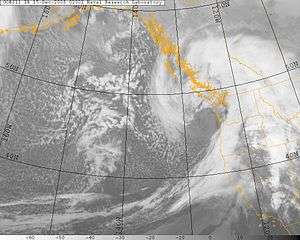Pacific Northwest windstorm

Pacific Northwest windstorms, sometimes colloquially known as Big Blows,[1] are extratropical cyclones which form in the Pacific basin, and affect land areas in the Pacific Northwest of the United States and British Columbia, Canada. They form as cyclonic windstorms associated with areas of low atmospheric pressure that track across the North Pacific Ocean towards western North America. Deep low pressure areas are relatively common over the North Pacific. They are most common in the winter months. On average, the month when most windstorms form is December.
The closest analogue to these storms are European windstorms, which also develop over the eastern portion of a major ocean.<ref "name=Mass&Dotson" >Mass, Clifford; Dotson, Brigid (2010). "Major Extratropical Cyclones of the Northwest United States: Historical Review, Climatology, and Synoptic Environment". Monthly Weather Review. 138 (7): 2499–2527. Bibcode:2010MWRv..138.2499M. doi:10.1175/2010MWR3213.1. Retrieved August 18, 2013.</ref>
Categories and frequency

| Average Peak Instant Gust (mph) | Windstorm Category | Approximate Return Interval |
|---|---|---|
| 39-44 | Minor | Several per year |
| 45-54 | Moderate | Annual |
| 55-64 | Major | Once every 2–3 years |
| 65-74 | Extreme | Once every 5–10 years |
| 75+ | Phenomenal | Once every 25–50 years |
Notable Pacific Northwest windstorms
- 1880: Great Gale of 1880
- 1921: January 29, the Great Olympic Blowdown.
- 1962: Columbus Day Storm began life as tropical storm Typhoon Frieda/Freda.
- 1979: February 13 windstorm leads to the catastrophic failure of the Hood Canal Bridge.
- 1981: Friday the 13th Windstorms, November 13–15.[3]
- 1990: November 22–24, Mercer island bridge sinking Washington state.[4]
- 1993: Inauguration Day windstorm, January 20. Claimed five lives, 750,000 homes and businesses without power with total damage in western Washington of $130 million.[5]
- 1995: December 11–12.[6]
- 2002: South Valley Surprise of 2002
- 2006: Hannukah Eve windstorm.[7]
- 2007: Great Coastal Gale of 2007
- 2015: November 16 Windstorm knocking out power to 220,000 households.
- 2016: Ides of October storm (overview[8])
References
- ↑ Knox, John A.; Frye, John D.; Durkee, Joshua D.; Fuhrmann, Christopher M. (2011). "Non-Convective High Winds Associated with Extratropical Cyclones" (PDF). Geography Compass. 5 (2): 63–89. doi:10.1111/j.1749-8198.2010.00395.x. Retrieved April 16, 2013.
- ↑ "Some Historical Weather Events in the Pacific Northwest". Office of Washington State Climatologist. Retrieved April 15, 2013.
- ↑ Read, Wolf. "Two Windstorms in Three Days November 13–15, 1981". The Storm King, hosted by the Office of Washington State Climatologist. Retrieved April 17, 2013.
- ↑ "Wind Storms". Office of Emergency Management, Seattle. Retrieved April 15, 2013.
- ↑ "Washington's Top 10 Weather Events of 1900s". National Weather Service, Portland Oregon. Retrieved April 17, 2013.
- ↑ Read, Wolf. "The Major West Coast Windstorm of December 12, 1995". The Storm King, hosted by the Office of Washington State Climatologist. Retrieved April 14, 2013.
- ↑ Read, Wolf. "December 14-15, 2006 Windstorm". The Storm King, hosted by the Office of Washington State Climatologist. Retrieved April 14, 2013.
- ↑ "The mid-October windstorm in the Pacific Northwest | NOAA Climate.gov". www.climate.gov. 28 October 2016. Retrieved 1 November 2016.
External links
- Wolf Read: The Storm King- Some Historical Weather Events in the Pacific Northwest
- KCTS9 Science Cafe: Great Windstorms of the Pacific Northwest with Dr. Cliff Mass